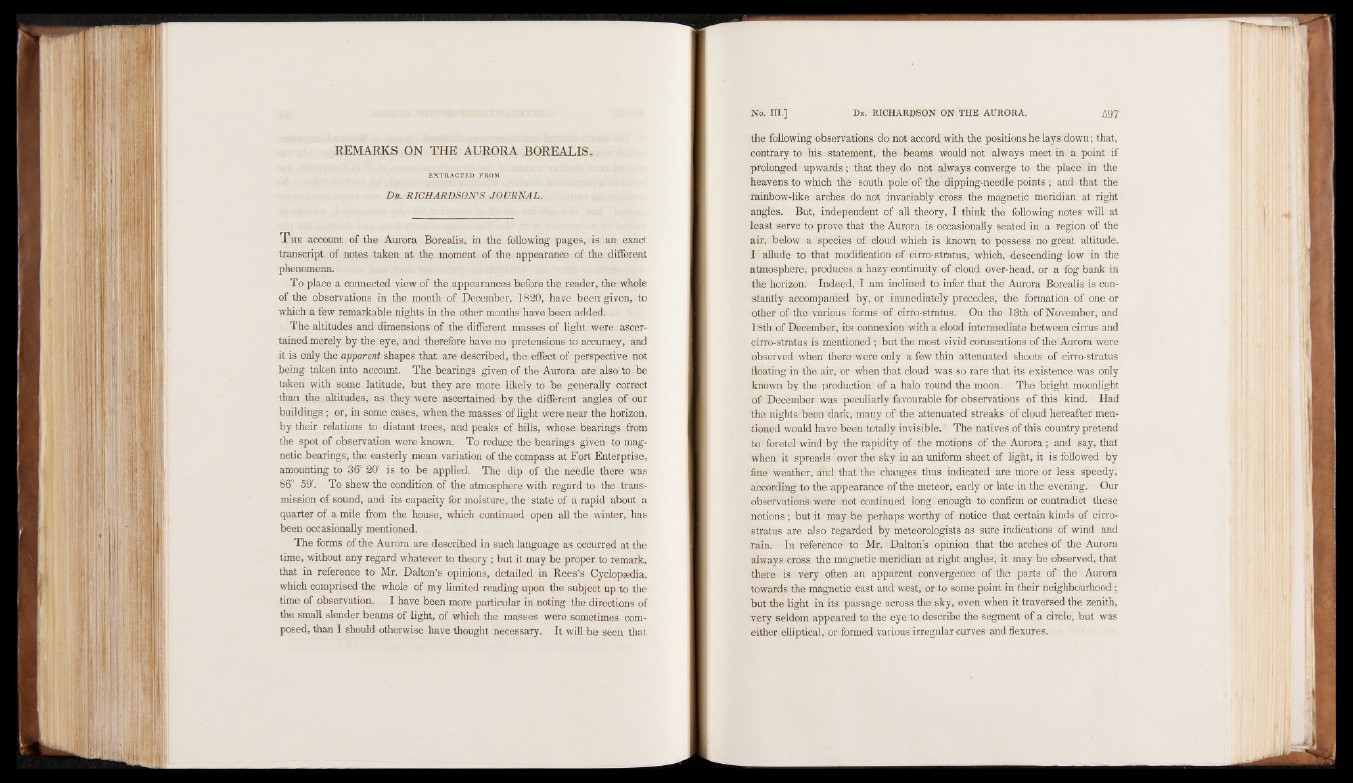
REMARKS ON THE AURORA BOREALIS,
EXTRACTED FROM
Dr. R I C H A R D S O N 'S J O U R N A L \
T he account of the Aurora Borealis, in the following pages, is an exact,
transcript of notes taken at the moment of the appearance of the different
phenomena.
To place a connected view of the appearances before thb reader, the whole
of the observations in the month of December, 1820, have been given, to
which a few remarkable nights in the other months have been added.
The altitudes and dimensions of the different masses of light were ascertained
merely by the eye, and therefore have no pretensions to accuracy, and
it is only the apparent shapes that are described, the effect of perspective not
being taken into account. The bearings given of the Aurora are also to be
taken with some latitude, but they are more likely to be generally correct
than the jjaltitudes, as they were ascertained by the different angles of our
buildings ; or, in some cases, when the masses of light were near the horizon,
by their relations to distant trees, and peaks of hills, whose bearings from
the spot of observation were known. To reduce the bearings given to magnetic
bearings, the easterly mean variation of the compass at Fort Enterprise,
amounting to 36° 20' is to be applied. The dip of the needle there was
86° 59'. To shew the condition of the atmosphere with regard to the transmission
of sound, and its capacity for moisture, the state of a rapid about a
quarter of a mile from the house, which continued open all the winter, has
been occasionally mentioned.
The forms of the Aurora are described in such language as occurred at the
time, without any regard whatever to theory ; but it may be proper to remark,
that in reference to Mr. Dalton’s opinions, detailed in Rees’s Cyclopaedia,
which comprised the whole of my limited reading upon the subject up to the
time of observation. I have been more particular in noting the directions of
the small slender beams of light, of which the masses were sometimes composed,
than I should otherwise have thought necessary. It will be seen that
the following observations do not accord with the positions he lays down; that,
contrary to his statement, the beams would not always meet in a point if
prolonged upwards; that they do not always converge to the place in the
heavens to which the south pole of the dipping-needle points ; and that the
rainbow-like arches do not invariably cross the magnetic meridian at right
angles. But, independent of all theory, I think the following notes will at
least serve to prove that the Aurora is occasionally seated in a region of the
air, below a 'species of-cloud which is known to possess no great altitude.
I allude to that modification of cirro-stratus, which, descending low in the
atmosphere, produces a hazy continuity of cloud over-head, or a fog bank in
the horizon. Indeed, I am inclined to infer that the Aurora Borealis is constantly
accompanied by, or immediately precedes, the formation of one or
other of the various forms of cirro-stratus. On the 13th of November, and
18th of December, its connexion with a cloud intermediate between cirrus and
cirro-stratus is mentioned ; but the most vivid coruscations of the Aurora were
observed when there .were only a few thin attenuated shoots of cirro-stratus
floating in the air, or when that cloud was so rare that its existence was only
known by the production of a halo round the moon. The bright moonlight
of December was peculiarly favourable for observations of this kind. Had
the nights been dark, many of the attenuated streaks of cloud hereafter mentioned
would have been totally invisible. The natives of this country pretend
to foretel wind by the rapidity of the motions of the Aurora ; and say, that
when it spreads over the sky in an uniform sheet of. light, it is followed by
fine weather, abd that the. changes thus indicated are more or less speedy,
according to the appearance of the meteor, early or late in the evening. Our
observations were not continued long enough to confirm or contradict these
notions ; but it may be perhaps worthy of notice that certain kinds of cirro-
stratus are also regarded by meteorologists as sure indications of wind and
rain. In reference: to Mr. Dalton’s opinion that the arches of the Aurora
always cross the magnetic meridian at right angles, it may be observed, that
there. is very often an apparent convergence-; of the parts of the Aurora
towards the magnetic east and west, or to some point in their neighbourhood;
but the light in its passage across the sky, even when it traversed the zenith,
very seldom appeared to the eye to describe the segment of a circle, but was
either elliptical, or formed various irregular curves and flexures.